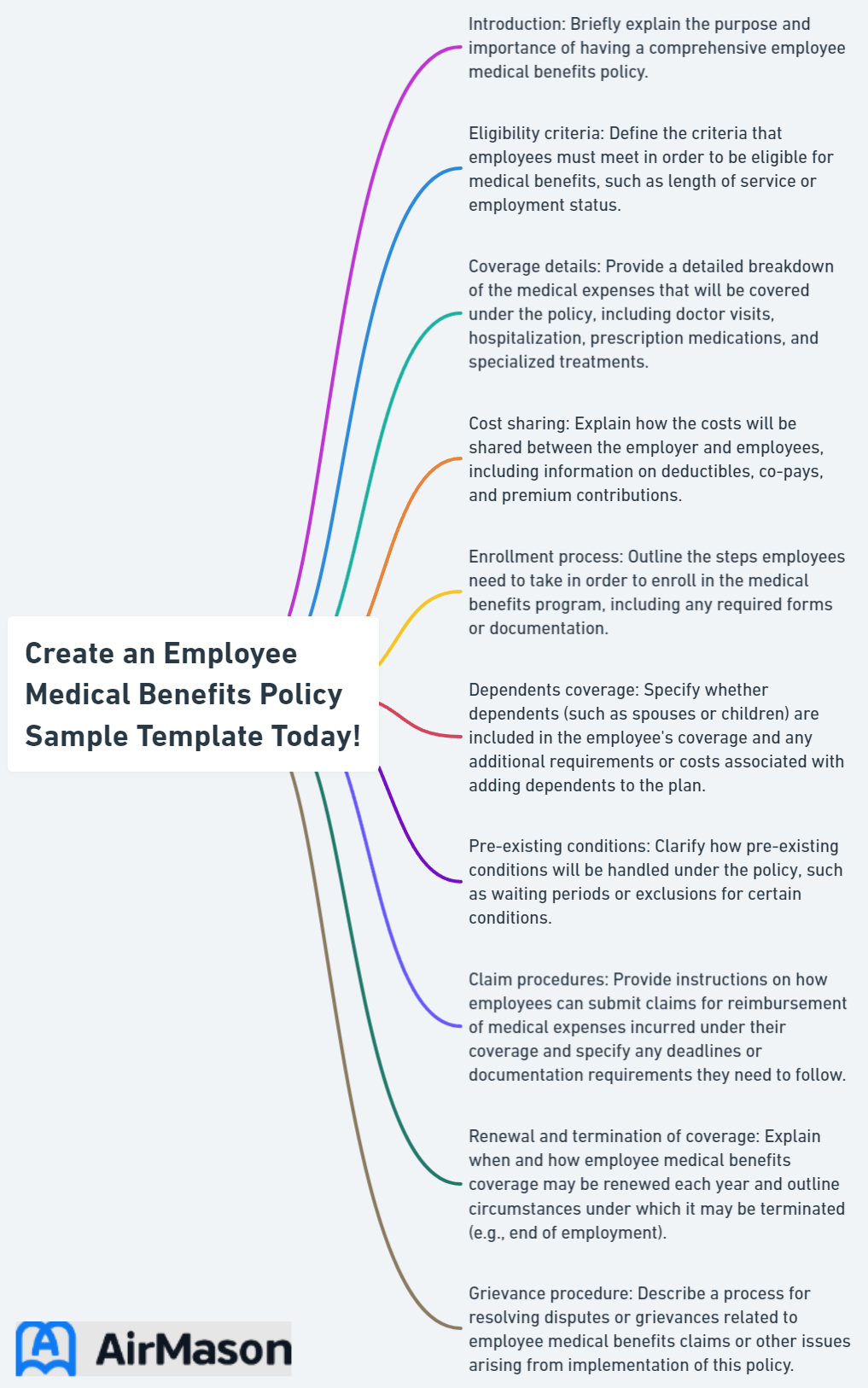
Picture this: Your company is thriving, but you’ve noticed that employee turnover is higher than you’d like. You know that a comprehensive medical benefits policy can make all the difference in attracting and retaining top talent, but where do you start? With healthcare costs on the rise and ever-changing regulations, it can feel overwhelming. Fear not! In this blog post, we’ll guide you through the process of creating and implementing an employee medical benefits policy sample that will be the envy of your industry.
We’ll dive into the importance of understanding medical benefits policies, explore the components of a well-rounded employee medical benefits policy sample, and offer tips on designing your own custom template. Along the way, we’ll share examples of successful policies and provide practical advice for clear communication, employee training, and ongoing support. By the end of this post, you’ll be well-equipped to create a medical benefits policy that caters to your employees’ needs and contributes to the success of your business.
Key Takeaways
- Designing an effective employee medical benefits policy requires understanding company needs, consulting with HR and legal experts, monitoring and adjusting the policy regularly.
- Implementing a successful medical benefits policy involves clear communication, employee training programs and ongoing support to ensure employees are aware of their rights.
- Examples from leading companies such as Airbnb, Salesforce & Microsoft demonstrate comprehensive coverage options for healthcare plans & other provisions.
What is Workplace Policy
A workplace policy is a set of guidelines and rules established by an organization to govern the behavior and conduct of its employees. “What is workplace policy” refers to the comprehensive framework that outlines the expectations, rights, and responsibilities of both the employer and the employees within the work environment. This essential document serves as a roadmap for maintaining a harmonious workplace, addressing issues such as communication protocols, ethical standards, and compliance with relevant laws and regulations. A well-defined workplace policy not only fosters a positive work culture but also ensures a fair and consistent approach to various situations, promoting transparency and accountability among all stakeholders.
Understanding Employee Medical Benefits Policy
A thriving workplace is built on employee benefits, with an effective policy being a key factor in maintaining a healthy and happy workforce. Providing medical care not only demonstrates concern for your employees’ well-being but also constitutes a strategic business decision. Research has shown that companies with strong benefits policies enjoy higher employee retention and productivity rates. But what makes a good employee medical benefits policy?
A solid medical benefits policy goes beyond meeting legal requirements and should be designed with the employee’s needs in mind. It should cover a variety of components, such as health insurance, workers’ compensation, and wellness programs. Grasping the purpose of medical benefits along with their legal requirements equips you to devise a policy that aligns with your company’s values while promoting your employees’ well-being.

Purpose of Medical Benefits Policy
The primary objective of a Medical Benefits Policy is to provide employees with access to healthcare services and bolster their overall well-being. This is essential for attracting and retaining top talent, as high-quality medical insurance demonstrates your commitment to employee health and financial security. In turn, this can help improve employee efficiency and productivity.
The scope of health insurance coverage should be comprehensive, providing group health benefits that cover employees and their dependents with provisions for dental, vision, and other supplemental insurance. Offering robust health coverage empowers your employees to manage their health, fostering a happier, healthier, and more productive workforce.
Legal Requirements
When designing your employee medical benefits policy, it’s crucial to consider the legal requirements that vary by location. Generally, these requirements include provisions for health insurance, workers’ compensation, and family medical leave.
Consulting with HR and legal experts is a vital step in ensuring your policy complies with all laws and regulations, while also addressing your employees’ needs. This can help protect your company from potential legal liabilities and ensure that your policy is both fair and effective for all parties involved.
Components of an Employee Medical Benefits Policy Sample

A well-rounded employee medical benefits policy should encompass a variety of components, each addressing different aspects of employee health and well-being. Let’s explore the three key elements that make up a comprehensive medical benefits policy: health insurance coverage, workers’ compensation, and wellness programs.
Incorporating these elements into your policy provides a safety net for your employees, covering medical expenses, promoting a healthy lifestyle, and offering support during work-related injuries or illnesses. This holistic approach to employee medical benefits can go a long way in fostering a positive work environment and promoting employee satisfaction, while also addressing employee expenses.
Health Insurance Coverage
Health insurance coverage is the cornerstone of any employee medical benefits policy, and it’s vital to offer options that cater to the diverse needs of your workforce. This includes coverage for employees and their dependents, with provisions for dental, vision, and other supplemental insurance. Partnering with a reliable insurance provider can help ensure the best possible benefits for your employees.
In addition to providing comprehensive coverage, it’s essential to consider the different types of health insurance plans available, such as:
- Preferred Provider Organization (PPO) plans
- Health Maintenance Organization (HMO) plans
- Fee-for-Service (FFS) plans
- Health Reimbursement Arrangement (HRA) plans
Offering diverse plan types allows your employees the flexibility to select the coverage that best aligns with their individual needs.
Workers’ Compensation
No employee medical benefits policy is complete without addressing workers’ compensation. This insurance provides financial support and medical care for employees who experience work-related injuries or illnesses.
Offering workers’ compensation not only adheres to workers compensation laws but also safeguards both your company and your employees. For employers, workers’ compensation serves as a form of protection from potential litigation and helps contain costs. For employees, it guarantees access to medical care, provides income support, and offers disability benefits. It’s a win-win situation that fosters a supportive and secure work environment.
Wellness Programs

Wellness programs are a valuable addition to any employee medical benefits policy, as they promote a healthy work environment and help prevent illness and injury. These programs can include initiatives such as smoking cessation, fitness programs, and mental health support.
Investing in wellness programs contributes to the overall health of your employees and yields benefits such as increased productivity, reduced healthcare costs, and improved employee retention. It’s a smart investment that can pay off in the long run, both in terms of employee well-being and company success.
Designing Your Own Employee Medical Benefits Policy Template
With a solid understanding of the key components and legal requirements of an employee medical benefits policy, you’re now ready to design your own custom template. This process involves assessing your company’s needs and budget, consulting with HR and legal experts, and monitoring and adjusting the policy as necessary.
Following these steps will enable you to craft a medical benefits policy tailored to meet your company’s unique needs and goals. This will ensure that your employees have access to the healthcare services they need while also contributing to the overall success of your business.
Assess Company Needs and Budget
The first step in designing your own employee medical benefits policy template is to assess your company’s needs and budget. This involves evaluating your current benefits costs and projecting future costs. Doing so will allow you to determine the suitable level of medical benefits for your employees and allocate resources to provide comprehensive coverage.
It’s important to strike a balance between offering competitive medical benefits and maintaining a healthy bottom line for your company. A careful analysis of your company’s financial position and your employees’ needs will help you craft a cost-effective medical benefits policy that benefits everyone involved.
Consult with HR and Legal Experts
Once you’ve assessed your company’s needs and budget, it’s time to consult with HR and legal experts. These professionals can help ensure that your policy complies with all applicable laws and regulations, as well as tailor the policy to your organization’s specific requirements.
Involving HR and legal experts in the policy creation process can help you avoid potential legal pitfalls and ensure that your policy is fair, effective, and compliant with all relevant laws. This will give you peace of mind and allow you to focus on providing the best possible medical benefits for your employees.
Monitor and Adjust Policy
Once your employee medical benefits policy is in place, it’s crucial to regularly monitor and adjust the policy as needed. This ensures that it remains effective and meets the needs of your employees.
You can monitor the effectiveness of your policy by:
- Conducting employee surveys
- Analyzing data
- Measuring health outcomes
- Tracking program participation
By staying attuned to the needs of your employees and making adjustments as necessary, you can ensure that your medical benefits policy remains relevant, effective, and beneficial for all parties involved.
Key Policy for Employees
In our organization, the “Key Policy for Employees” serves as the foundation for fostering a positive work environment. This comprehensive set of guidelines outlines the essential principles and expectations that employees are encouraged to adhere to in order to ensure a harmonious and productive workplace. As part of our commitment to transparency and fairness, the “Key Policy for Employees” addresses various aspects, including performance expectations, communication protocols, and professional conduct. By familiarizing themselves with this key policy, employees can contribute to a cohesive work culture that values accountability, collaboration, and mutual respect.
Tips for Implementing and Communicating Your Medical Benefits Policy
Now that you have a well-designed employee medical benefits policy, it’s time to implement and communicate it effectively. Clear communication, employee training, and ongoing support are crucial to the success of your policy.
By implementing these strategies, you’ll not only ensure that your employees understand and appreciate their medical benefits but also create a positive work environment where employees feel supported and valued. In turn, this can lead to increased employee satisfaction, productivity, and retention.
Clear Communication
Clear communication is essential when rolling out your employee medical benefits policy. This can be achieved through written materials, meetings, and online resources. Providing comprehensive information about the policy empowers your employees to make informed decisions about their healthcare.
Visual aids, such as charts, graphs, and infographics, can also be utilized to enhance comprehension and retention of complex information. By combining clear, concise communication with visually engaging materials, you’ll ensure that your employees have a thorough understanding of their medical benefits and can make the most of their coverage.
Employee Training
Providing employee training is a crucial component of implementing your medical benefits policy. This involves educating employees on how to access and utilize their benefits, as well as any wellness programs or resources that are available.
Offering comprehensive training equips your employees with the necessary tools to optimize their medical benefits and efficiently utilize company equipment. This not only helps to improve employee satisfaction but also ensures that your investment in their health and well-being is being put to good use.
Ongoing Support
Ongoing support is essential for employees as they navigate their medical benefits. This can include assistance with claims, addressing questions and concerns, and providing resources for personal issues that may impact job performance.
Offering this level of support demonstrates your commitment to employee well-being and helps to foster a positive work environment. In turn, this can lead to increased employee satisfaction, productivity, and retention, ultimately contributing to the success of your business.
Examples of Successful Employee Medical Benefits Policies

Looking for inspiration? Consider the successful employee medical benefits policies of companies like Airbnb, Salesforce, and Microsoft. These organizations are renowned for their comprehensive medical benefits packages, which include health, dental, and vision insurance, as well as life insurance and retirement planning. By offering a variety of coverage options and adjustable choices for healthcare plans, these companies demonstrate a commitment to employee well-being through their well-managed company accounts, including provisions like a company car.
Let these examples serve as a guide as you create your own employee benefits policy, including medical benefits, for eligible employees. Offering a well-rounded policy that meets the diverse needs of your workforce sets the stage for a healthy, happy, and productive work environment.
Summary
In conclusion, creating a successful employee medical benefits policy requires a thorough understanding of the components, legal requirements, and best practices involved. By designing your own custom policy that meets the needs of your employees and adhering to clear communication, employee training, and ongoing support, you will contribute to a healthy and productive work environment.
Remember that investing in your employees’ well-being is not only a moral obligation but also a smart business move. By providing comprehensive medical benefits, you’re creating a positive work environment that attracts and retains top talent, ultimately leading to the success of your company. So, why wait? Start creating your Employee Medical Benefits Policy Sample Template today!
Policy for Working Remotely
Our “Policy for Working Remotely” is designed to provide clear guidelines and expectations for employees engaging in remote work arrangements. This policy outlines the procedures and responsibilities associated with working outside the traditional office setting. It addresses key aspects such as communication protocols, work hours, and the use of company resources to ensure a smooth transition to remote work while maintaining productivity and accountability. Employees are encouraged to familiarize themselves with this policy and adhere to its guidelines to foster a successful and collaborative remote work environment.
Frequently Asked Questions
What is an example of employee benefit policy?
Employee benefit policies commonly include health insurance, stock options and medical insurance. Some employee benefits vary by country, such as life insurance which is an important component of employee benefits.
What are the 4 major types of employee benefits?
Employee benefits typically include Health Insurance, Life Insurance, Short-Term and Long-Term Disability and Retirement Plans.
What are the key components of an Employee Medical Benefits Policy?
A comprehensive Employee Medical Benefits Policy includes health insurance coverage, workers’ compensation, and wellness programs to ensure employees’ physical and mental wellbeing.
What legal requirements should be considered when creating a medical benefits policy?
Creating a medical benefits policy should take into account legal requirements such as health insurance, workers’ compensation, and family medical leave.
How can I ensure effective communication when implementing a medical benefits policy?
Ensure effective communication when implementing a medical benefits policy by utilizing written materials, holding meetings, and providing online resources with visual aids.

